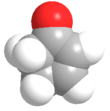- Cyclopentenone
-
Cyclopentenone 
 2-Cyclopenten-1-one
2-Cyclopenten-1-oneIdentifiers CAS number 930-30-3 
PubChem 13588 ChemSpider 12999 
ChEMBL CHEMBL52190 
Jmol-3D images Image 1 - C1CC(=O)C=C1
Properties Molecular formula C5H6O Molar mass 82.04 g·mol−1 Density 0.98 g·mL−1 Boiling point 150 °C
Solubility in water almost insoluble in water Hazards Main hazards Harmful Flash point 42 °C  (verify) (what is:
(verify) (what is:  /
/ ?)
?)
Except where noted otherwise, data are given for materials in their standard state (at 25 °C, 100 kPa)Infobox references Cyclopentenone is a hydrocarbon with chemical formula C5H6O and CAS number 930-30-3. It is structurally similar to cyclopentanone, with the additional feature of α-β unsaturation in the ring system. Cyclopentenone belongs to the cycloalkene (alkenes which have one or more rings of carbon atoms) class of compounds and is also a ketone (it possesses a carbonyl functional group). It is a liquid at room temperature with a boiling point of 150 °C. It has been isolated from pressure-cooked pork liver by simultaneous steam distillation and continuous solvent extraction.[1]
The term cyclopentenone may also refer to a structural motif wherein the cyclopentenone moiety is a subsection of a larger molecule. In this regard, cyclopentenones are found in a large number of natural products, including jasmone, the aflatoxins, and several prostaglandins.
Synthesis
Cyclopentenones can be synthesized in a number of ways. Industrially, the most common procedures are elimination of α-bromo-cyclopentanone using lithium carbonate[2] and Claisen condensation-decarboxylation-isomerization cascades of unsaturated diesters as shown below.[3]
As a functional group, the synthesis of cyclopentenones is accomplished in a variety of other ways, including the Nazarov cyclization reaction from divinyl ketones, Saegusa–Ito oxidation from cyclopentanones, ring-closing metathesis from the corresponding dienes, oxidation of the corresponding cyclic allylic alcohols, and the Pauson–Khand reaction from alkenes, alkynes, and carbon monoxide.[4]
Reactions
As an enone, cyclopentenone undergoes the typical reactions of α-β unsaturated ketones, including nucleophilic conjugate addition, the Baylis–Hillman reaction, and the Michael reaction. Cyclopentenone also functions as an excellent dienophile in the Diels–Alder reaction, reacting with a wide variety of dienes. In one example, a Danishefsky-type diene is reacted with a cyclopentenone to yield a fused tricyclic system en route to the synthesis of coriolin.[5]
References
- ^ Mussinan,C.J.; Walradt, J.P. (1974), J. Agric. Food Chem. 22 (5): 827–831, doi:10.1021/jf60195a002
- ^ US EP1418166, Daisuke, Fukushima & Hirata Norihiko, "Process for producing 2-bromocyclopentanone", published 2004-05-12
- ^ US EP1422212, Liang, Shelue; Andrea Haunert & Sylvia Huber-Dirr et al., "Process for preparing cyclopentenone", published 2004-11-25
- ^ Organic Reactions Portal "Cyclopentenone synthesis"
- ^ Danishefsky, S.; Zamboni, R.; Kahn, M.; Etheredge, S.J. (1980), J. Am. Chem. Soc. 102 (6): 2097–2098, doi:10.1021/ja00526a061
Categories:- Ketones
Wikimedia Foundation. 2010.


